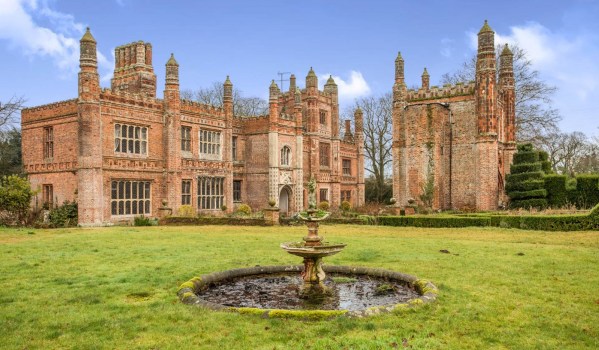Featured Image from: Zoopla
If you want to know more about a certain area, take a look at the ancestral homes in the area. The architecture says a lot about the past, and most ancestral homes are filled with trinkets that tell stories of the past.
With its rich history of kings and nobility, the United Kingdom has plenty of ancestral homes and various types of it. Unlike countries where ancestral homes are simply places where generations of a certain family have lived, the UK has various types of ancestral homes. In this sense, an ancestral homes are not the mansions that people in other countries would call their ancestral homes; rather, it’s the small homes that poorer families live in because they can’t afford to move elsewhere.
If we’re talking about the large mansions and manors at the countryside that have stood the test of time, there are also various types such as historic houses, great houses, manor houses, and more. The country home, however, is the most popular type. And while several of these houses have fallen into ruin or were demolished following the wars, those that have survived tell a great story of the UK’s past.
Town and Country Homes
Most country homes were large houses or mansions, but they were never as big as a great house usually owned by royalty or manor houses that belonged to lords and higher nobility. They were also rarely occupied by the master or the lady of the house, as those that owned country houses also owned a town house to go to for business in the city.
Royalty, nobles, and gentry could afford to have a country house. It’s important to understand that, at that time, nobles had a title but it was possible for them to not be wealthy. In a similar vein, the gentry – a social class of landowners – could be wealthy enough to live an independently wealthy lifestyle without ever earning a title. Because not all gentry could afford a townhouse, they were the only ones who lived in a country home full-time.
How Country Homes Affected Local Economies
Having a big house like this in the past meant that there was more opportunity for commoners to work. Wealthy families often required a team of staff to handle the day-to-day necessities. While country houses are not as big or require various maids or an army of staff, a country home may need large numbers to have staff available for the master and his family around the clock.
The gentry who owned land usually built their country home within the land. Apart from household staff, rural commoners could also opt to work on the land. Landowners made their money by charging people for staying on their land; once they had enough, landowners who could live independently on the income alone were considered members of the gentry.

Growth and Peak of the Country House
After the feudal period and wealthy houses and families did not live in fortified castles, country homes became popular during the Tudor period. The earliest country houses were monasteries in England during Henry VIII’s reign. During that time, Henry VIII declared himself head of the Church of England, dissolving monasteries and giving them to his favorite courtiers. Eventually, these were converted into private homes that would then become country houses.
His daughter, Elizabeth I, and his great-grandnephew, James I, would later continue the trend. Architects were commissioned to design mansions that would eventually become the typical design of a country house. These were built with the intention to be beautiful enough to attract a travelling monarch’s interest to visit the family who occupied the house. Eventually, by the 18th century, neoclassical architecture had taken over, but by then the idea of country houses had become popular, resulting in a mixture of country home styles.
Aside from the gentry who lived in these homes full-time, nobility and royalty treated country homes like the summer houses we use today. When tired of their jobs and duties in London, which was at the time, they escape the bustle and heat and head to the country to recuperate for as long as they could.
Unlike great houses in the country that were meant to exude wealth and power, country homes during the 18th and 19th century were used by the wealthy as a sort of vacation home or an oasis to escape. But to the commoners, it was a center of employment, as at the time, the crown was not providing its people with benefits or aid unless absolutely necessary.
Decline
By the turn of the 20th century, the traditional land income and lifestyle of the country home began to dwindle. Apart from the upkeep costs of a country home, homeowners were being taxed more due to the incoming war. Eventually, these homes were abandoned and left to rot with time. Those that weren’t ruined after the war were either demolished or converted for other purposes.
Around the 1870s, there was an agricultural depression where crops and other land were no longer as valuable as it once was. The effects of this on both the gentry and nobility’s finances did not take a dip until a decade later, when they were experiencing financial difficulties. Add in the fact that taxes were also increasing, and landowners sought to find different ways to keep their country homes.
Like a huge part of Downton Abbey’s plot, a lot of wealthy families were trying to keep the wealth in the family by any means necessary. The cousin of both Winston Churchill and Princess Diana, the Duke of Marlborough, married a Vanderbilt heiress for $2.5 million (worth around $66 million today).
The onset of World War I did little to help the situation. Household staff had chosen to either fight or help out in the war efforts. After the war, with many dead and plenty of positions vacant, many of these staff chose to work in the city instead. Plenty of houses, lacking in staff, fell into disrepair.
By the time World War II arrived, the government took plenty of these homes from civilians and used it for military purposes. After the war, plenty of these homes were in poor conditions. With more deaths, (including heirs and entire families) larger taxes, and abysmal income from land, many chose to either sell their country homes to re-earn some of their wealth, sell their home in parts, or left it to rot.

The Country House Today
The homes that did survive had to adapt, as no one was willing to pay to renovate old houses as a residential property. By the 1920s, these structures were converted into commercial properties, providing accommodations to tourists, schools and hospitals for locals, and more. Country houses with significant historical value, including those ruined through time, were preserved and kept as museums. By the 1970s, those that failed to adapt to the changing times were demolished.
Go to the countryside and you may be surprised by what you may find. Don’t expect to find the old lords and ladies living in these country homes, but notice the architecture of some commercial properties. If they seem old, you may be looking at one of the few country houses that survived the rise and falls of the UK’s history.



